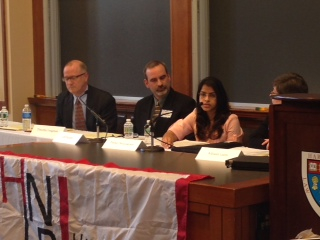A recent symposium on restorative justice at Harvard University gave Eastern Mennonite University (EMU) professor Carl Stauffer an opportunity to speak on lessons learned from the South Africa Truth and Reconciliation Commission and call attention to Sierra Leone for an accomplishment beyond the latest Ebola update.
Stauffer spoke about Fambul Tok, a national, grassroots movement that is enabling the country to heal deep psychosocial wounds left by a civil war that lasted from 1991 to 2002. He suggested that this movement had proven to be more effective – more truly restorative – than the top-down criminal prosecutions pursued in many countries, including Sierra Leone, after violent conflicts.
Stauffer spoke from first-hand experience. From 2000 to 2009, Stauffer was Mennonite Central Committee’s Regional Peace Adviser for the Southern Africa region, a role that took him to 20 African countries and 10 other countries in the Caribbean, Middle East, Europe, and the Balkans. He and his family lived in Africa for a total of 16 years; he earned a PhD studying how mythology fueled violence in Zimbabwe.

As an invited expert to the Harvard Negotiation Law Review symposium, Stauffer was one of three in a panel discussion on “restorative principles in transitional justice.” Alongside him was alumna Pushpi Weerakoon, a native of Sri Lanka who earned her master’s degree from EMU’s Center for Justice and Peacebuilding in 2010. Today she is a scholar and fellow at the Harvard Kennedy School.
Sierra Leone and Sri Lanka as examples
In keeping with the theme of the Feb. 28 symposium, “Restorative Justice: Theory Meets Application,” both Stauffer and Weerakoon drew upon examples from specific countries (Sierra Leone for Stauffer; Sri Lanka for Weerakoon) to make the following general points, using words from a paper published previously by Weerakoon:
Restorative justice is about healing, not judgment; about recognizing the uniqueness of a situation and individuals, not blindly following the rule-based system of law; it is about compassion not control; about dialogue not advocacy; about recognition of the harm, and not apportionment of guilt. Restorative justice empowers people who are typically silenced or marginalized; it deals with people, not process and system; it builds rather than fragments communities; and it is cathartic and a legitimate end in itself.
Weerakoon’s words are universal, but she was writing in reference to Sri Lanka’s 26 years of war and its aftermath, once the government defeated the separatist Tamil fighters in 2009. Now there are thousands of individuals who were formerly child soldiers and who need to be re-integrated into society. Meanwhile, United Nations officials have repeatedly criticized the government for ongoing violations of human rights. During the war, both sides were shown to have acted unconscionably.

Weerakoon and Stauffer were surrounded by a sympathetic crowd at Harvard. Three 2011 MA graduates of CJP were among the 85 people in the audience at various points in the day: Barbara Robbins, Judy Clarke, and Rebecca Stone. Among the other invited speakers were a number of restorative justice experts whose writings are studied at CJP, including Harvard law school dean Martha Minow; Daniel Van Ness of Prison Fellowship International; and Mark Umbreit, founding director of the Center for Restorative Justice and Peacemaking at the University of Minnesota.
How Fambul Tok works
The spring-summer 2011 issue of EMU’s Peacebuilder magazine contained a profile of Stauffer, who now co-directs EMU’s Zehr Institute for Restorative Justice, and a summary of the Sierra Leone example cited by him at Harvard. This is that summary, slightly edited:
In 2006, we partnered with John Caulker who had an organization called ‘Forum for Conscience’ in Sierra Leone. We used some of the same material there as in South Africa, working with entire affected communities — seven to ten thousand had their legs and arms amputated in the civil war in Sierra Leone and so many were blinded, they have their own associations. There were ex-combatants associations. Bush wives associations. Those groups – we brought them together – 25 to 30 in each of those first workshops in 2006 and 2007.
John helped us to understand the importance of conducting a healing process that would run parallel to the formal Truth and Reconciliation process, which only operated at the upper tip of society. John wanted to start rebuilding his country individual by individual, family by family, village by village, from the base up by simply listening and talking to each other.
Catalyst for Peace, a private foundation in Maine, has committed to funding the Fambul Tok process for 15 years, an impressive, long-term commitment without a lot of strings attached. And it’s working!
Our current international justice system needs to recognize initiatives such as Fambul Tok as significant community healing and justice processes. I’m convinced with appropriate research we could make a solid argument that this form of community-level justice is actually more satisfying and more effective for the rebuilding of Sierra Leone than the singular use of a Truth Commission or the International Criminal Court. The Criminal Court – for instance – built a building in the capital of Sierra Leone that cost millions. And then the court took four years to try nine people.
The reason it took four years to do nine cases is because they were trying to establish all of the details of the atrocities that these nine leaders did during the civil war. While these factors are important, they are certainly not all that the country needs in order to resolve its pain. As is the case in so many war-torn regions, Sierra Leone needs to be restored, justly, which is a long-term process that can only be done by the people themselves, one day at a time.
Stauffer is in his third year of a research project that assesses the value of community-level justice and reconciliation efforts through the study of Fambul Tok.
For more information on restorative justice, including studying the subject at EMU, visit this website.
